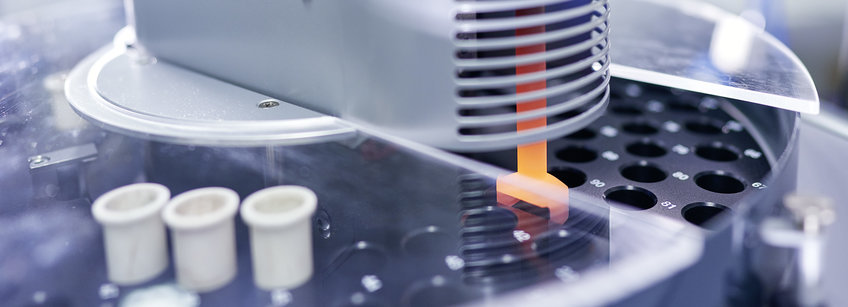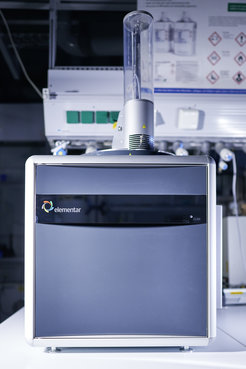
Elemental analysis
An important measuring method in our laboratory is elemental analysis that serves to measure the carbon and nitrogen content in soils, plants and other solid samples. By burning the sample at temperatures above 1000 °C, carbon and other elements such as nitrogen and sulphur are released from the samples. The proportions of the elements are recorded by detecting the gases produced.
For the measurement, the finely ground sample material is precisely weighed into ceramic cups or tin boats. Depending on the instrument and sample type, the sample weight can be as little as 1 mg or as much as 2000 mg. The weighed-in samples are placed on the autosampler of the measuring instrument and burnt at up to 1150 °C in an oxygen environment. Helium as carrier gas transports the oxidatively formed combustion gases through the instrument. In the downstream reduction tube, which can be filled with copper chips or tungsten granulate, the excess oxygen is bound. Nitrogen oxides are reduced to molecular nitrogen. In addition, silver wool adsorbs any halogens that may be present. Then the stoichiometrically defined reaction gases N2, CO2, H2O and SO2 are passed through a so-called purge and trap system similar to the one used in gas chromatography. One after the other, the individual gases are fed to a thermal conductivity detector (TCD) and quantified. The carrier gas helium also serves as reference gas.
Since the sequence of the detected gases is technically exactly determined with this measuring method, this allows both the unambiguous identification (qualitative determination) and, at the same time, the quantity determination (quantitative determination) of the individual elements N and C, H, S via the integrated peak areas in the chromatogram. With the help of the known initial weight, the respective proportion of the element can then be precisely specified in mass % of the analysed sample.
A sample analysis takes 12 - 15 minutes, depending on the analyte content of the measured samples.
To ensure the highest possible accuracy of our measurements, the measuring instruments are regularly maintained and checked daily. In each newly started measurement sequence, chemical standards and certified reference materials are analysed before the samples are measured to prove the quality of the measurements.
In addition, our laboratory participates in the annually organised interlaboratory test of the Verband Deutscher Landwirtschaftlicher Untersuchungs- und Forschungsanstalten e.V., VDLUFA.

Elementar Analysensysteme GmbH,
Elementar-Straße 1, D-63505 Langenselbold, Germany
Parameters vario MAX cube
- Analyts: C, N, S
- Sample material: Pflanzen & Böden
- Sample weight: 50 - 2000 mg
- Sample preparation: fine grinding
Besides general routine tasks, RoMA develops and optimises application-specific analytical measurement methods. One example is the quantitative separation of organically and inorganically bound carbon in soil. This is a particular challenge due to the chemical properties of the organic material and the varying mineralogical composition of the carbonates, as well as the usually very different quantitative distribution of the components in relation to each other. A quantitative analysis usually starts with a total carbon determination on a representative sub-sample. For the quantitative determination of the individual components, a further sub-sample is treated either with a non-oxidising acid to break down the carbonate or with temperature-optimised combustion to break down the organic soil material.













